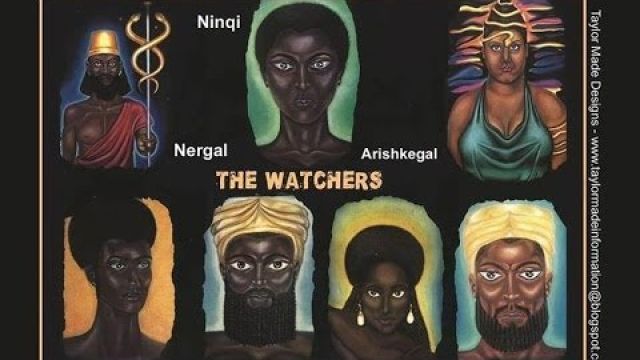Ancient Astronauts Theory Anunnaki Nephilim Ancient Aliens Hidden Secrets Full...
209 views
Uploaded by:
kazorchian
•
Category:
Extra Terrestrial
•
Added on
03 May 2015
Description
Overview Ancient astronauts proponents suggest that aliens came to Earth and profoundly affected the development of human civilization by manipulating the DNA of prehistoric hominids, citing evidence as found in this ancient Mesopotamian cylinder seal as proof of advanced technological influences...
Overview Ancient astronauts proponents suggest that aliens came to Earth and profoundly affected the development of human civilization by manipulating the DNA of prehistoric hominids, citing evidence as found in this ancient Mesopotamian cylinder seal as proof of advanced technological influences Proponents of the ancient astronaut hypotheses often maintain that humans are either descendants or creations of extraterrestrial beings who landed on Earth thousands of years ago. An associated idea is that much of human knowledge, religion, and culture came from extraterrestrial visitors in ancient times, in that ancient astronauts acted as a "mother culture". Ancient astronaut proponents also believe that travelers from outer space, referred to as "astronauts" (or "spacemen") built many of the structures on Earth (such as Egyptian pyramids and the Moai stone heads of Easter Island) or aided humans in building them.[6][7] Ancient astronauts hypothesis of creation Proponents argue that the evidence for ancient astronauts comes from documentary gaps in historical and archaeological records, and they also maintain that absent or incomplete explanations of historical or archaeological data point to the existence of ancient astronauts. The evidence is argued to include archaeological artifacts that they deem anachronistic, or beyond the accepted technical capabilities of the historical cultures with which they are associated. These are sometimes referred to as "out-of-place artifacts"; and include artwork and legends which are interpreted in a modern sense as depicting extraterrestrial contact or technologies. Legitimate academics have responded that gaps in contemporary knowledge of the past need not demonstrate that such speculative ancient astronaut ideas are a necessary conclusion to draw.[8] Thomas Gold, a professor of astronomy, suggested a "garbage theory" for the origin of life, proposing that life on Earth might have spread from a pile of waste products accidentally dumped on Earth long ago by extraterrestrials.[9] Artist rendering of the suspect FOXP2 protein The genetic argument Ancient astronaut creation theorists believe that language is a gift from the gods. Hypothesis proponents argue that the Forkhead box protein P2 (FOXP2) gene, which research shows to be linked with language,[10] is of extraterrestrial origin. The hypothesis contends extraterrestrials are responsible for giving mankind the ability to communicate, use tools, manipulate fire, socially organize and interact symbolically with one another. The ancient astronaut creation hypothesis further argues the possibility that all life on Earth is of extraterrestrial origin. Genetic research and brain evolution In 2004, researchers at the Howard Hughes Medical Institute, at the University of Chicago, Illinois, conducted a study and found human genes that control the size and complexity of the brain have undergone rapid evolution in humans, and that mammals and other non-human primates had not evolved in this manner.[11] Ancient astronaut creation theorists believe that this evolution is the result of extraterrestrial beings manipulating the DNA of early hominids as well as natural selection. Hypothesis origins and proponents A physiologically manipulated Nazca skull (housed at the Museo Regional de Ica in Peru). AAC theorists claim the culturally-based practice came about in as a societal attempt to emulate the bone structure of ancient alien visitors to earth. Paleocontact or "ancient astronaut" narratives first appeared in the early science fiction of the late 19th to early 20th century. The idea was proposed in earnest by Harold T. Wilkins in 1954; it received some consideration as a serious hypothesis during the 1960s; and has been mostly confined to the field of pseudoscience and pop culture since the 1970s. Ancient astronauts appear as a feature of UFO religions (beginning in 1967), with the Scientologist 'Scripture", and followed by Raelism (1974), and others.[citation needed] Alfred Russel Wallace This section contains information of unclear or questionable importance or relevance to the article's subject matter. Please help improve this article by clarifying or removing superfluous information. The AAC hypothesis challenges Charles Darwin's theory of natural selection. Proponents of the hypothesis cite the research and theory developed by one of Darwin's contemporaries, Alfred Russel Wallace, as at least partial basis for their beliefs. According to the ancient astronaut theorist, Craig Stanford, the theory of evolution by natural selection is inaccurate because Darwin had no means to gain a clear understanding of the amount of time that had passed since early hominids had started to walk upright, began the use of tools, and developed language. Wallace believed that an unseen creative spirit had interceded three times on planet Earth. First, to create life from inorganic matter; second, to create conscio
